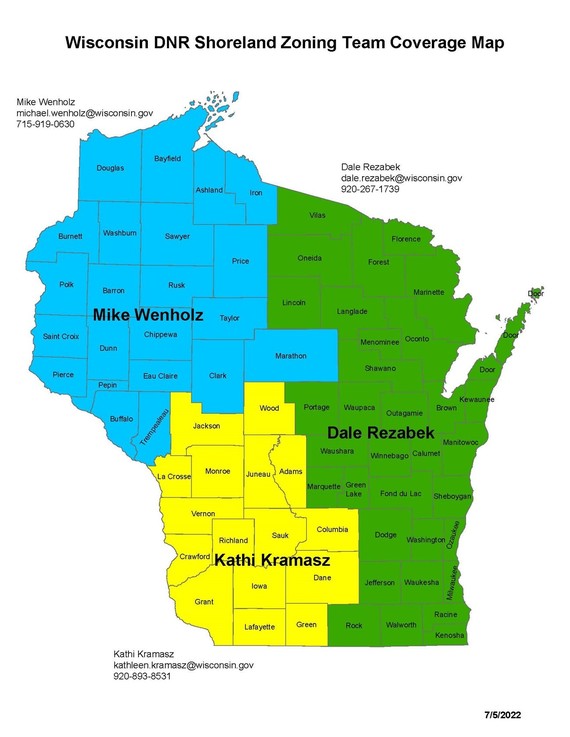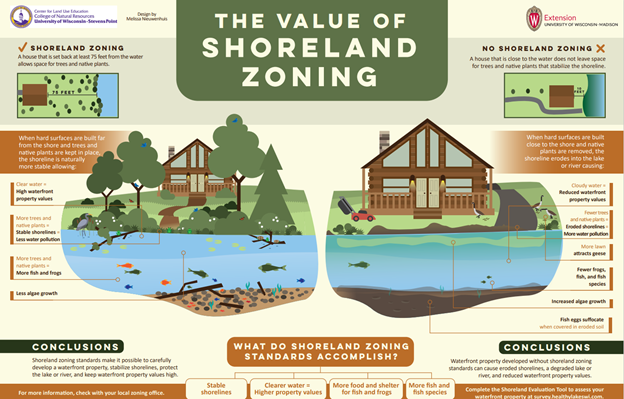|
The primary Statutory and Administrative Code roles of the DNR Shoreland Zoning Program are to be a contact for and maintain Chapters NR 115, NR 117 and NR 118, Wis. Admin. Code; prepare and provide model ordinances of NR 115, NR 117 and related statute (e.g., s. 59.692, Stats.); and provide assistance to counties and municipalities in developing and implementing their local state-mandated shoreland, shoreland-wetland, and Lower St. Croix National Scenic Riverway zoning ordinances.
Kathi Kramasz assists counties and municipalities with shoreland and shoreland-wetland zoning in the area shown on the map.
Kay Lutze is the Program Supervisor, assisting with shoreland, shoreland-wetland and Lower St. Croix National Scenic Riverway zoning issues (determined internally as needed).
Dale Rezabek assists counties and municipalities with shoreland and shoreland-wetland zoning in the area shown on the map.
Mike Wenholz is the Statewide Coordinator and contact for all Lower St. Croix National Scenic Riverway zoning, assisting counties and municipalities with shoreland and shoreland-wetland zoning in the area shown on the map.
Lynn Markham is a UW-Extension employee working with the Center of Land Use Education. She prepares publications and other educational materials and conducts a variety of trainings pertaining to shoreland zoning.

 The Shoreland Team believes this is an outstanding tool to help people understand the numerous values and benefits shoreland zoning provides, and could be distributed at meetings, seminars or possibly among lake property owners or associations. One waterfront property owner said the graphic is “the single most enlightening picture I have ever seen, where lakes are concerned.”
This graphic was developed by the Center for Land Use Education and Extension Lakes and can be downloaded as a PDF or you can order 11”x17” hardcopy handouts or posters for use in public locations.
You can also view a webinar recording about this graphic to learn more about it.

Ryan Pichler: Northeast Region
Please help us welcome Ryan Pichler to the program as a new WME for the NE region. Ryan started on Jan. 3 and will be stationed in the Green Bay office.
Ryan grew up in Green Bay and received a Bachelor of Science in civil engineering from UW-Platteville with emphases in environmental and geotechnical engineering. After college, he served as an AmeriCorps VISTA with Flatirons Habitat for Humanity in Boulder, Colorado. He worked in the water resources department at Ayres Associates in Eau Claire for four years, where his work consisted of dam inspections, hydrosurveys for dams and bridges, and hydrologic and hydraulic analyses (H&H) for bridges and floodplains. Ryan also worked for the city of Green Bay’s Public Works Department Utility Division for five years, where he worked on the implementation of the city's MS4 program, stormwater site plan review, lift station design, contract administration and assisted residents with backyard drainage issues.
He currently lives in De Pere with his wife and one-and-a-half-year-old daughter. He enjoys rafting, canoeing, fishing and nature photography, especially in state and national parks. He and his family hope to visit all the national parks and have had the opportunity to visit 14 so far.
|

Ryan Jarvis: West Central Region
We are happy to welcome Ryan Jarvis to Waterways’ Dam Safety & Floodplain team as a Water Management Engineer in the West Central Region. Ryan started on Jan. 17 and works out of the Eau Claire Service Station.
Ryan grew up near Hayward, Wisconsin. He received his Bachelor of Science in civil and environmental engineering at UW-Madison in 2011. After graduation, he moved to Eau Claire to work with a local engineering consulting firm. During that time, he earned his Professional Engineer license while working on a wide variety of projects including transportation, structural, bridge and culvert, and and hydrologic and hydraulic analyses (H&H) projects. His favorite projects were H&H. In 2018, Ryan changed focus and began working at the Wisconsin Department of Health Services (DHS) as a regulator of healthcare facilities, performing building inspections and plan review. Although his time at DHS was incredibly valuable and he enjoyed many of the aspects of the regulatory world, he missed the actual engineering.
When not at work, Ryan enjoys exploring new places with his dog Fezzik, being outside and working on DIY projects. He is very excited to begin his new career at the DNR and all of the learning ahead.
Please extend a warm welcome to Ryan!
|

Will Disser: Southern District
Will graduated from Georgia Tech in 2018 with a degree in environmental Engineering. Will started his career with the State of Michigan, where he spent the past three years as an engineer and regulator in their drinking water program. During that time, he reviewed permits for new water infrastructure, conducted water treatment plant inspections and worked closely with various municipalities and private entities across southeast Michigan to enforce the Safe Drinking Water Act and meet EPA reporting requirements. Will found the work very challenging and rewarding but was looking to return to his interests in floodplains and hydrology.
Will has had a chance to see a lot of the U.S. and has lived in seven states: Indiana, Florida, Washington, North Carolina, Wisconsin, Georgia and Michigan. He lived in Middleton, Wisconsin about ten years ago and Wisconsin felt like home, so he is happy to be back! Will loves to explore nature trails or get lost in a good book, and he is looking forward to getting local recommendations for both.
Find your county’s Water Management Engineer on the DNR’s Dam Contacts webpage.
|
If you’re a local official responsible for local floodplain management, consider attending the upcoming Managing Floodplain Development Course hosted by the DNR.
This four-day course is designed to provide a comprehensive, organized training opportunity for local officials responsible for administering their local floodplain management ordinance. The course focuses in-depth on the National Flood Insurance Program (NFIP) and concepts of floodplain management, maps and studies, ordinance administration, mitigation, flood insurance, base flood elevation (BFE) determination, elevation certificates and the relationship between floodplain management and flood insurance.
The target audience is local officials responsible for administering local floodplain management ordinances, including but not limited to floodplain management administrators, building inspectors, code enforcement/zoning officers, planners, city/county managers, attorneys, engineers, surveyors and public works officials. The course is designed for those officials with limited floodplain management experience.
Event Details
What: E0273 Managing Floodplain Development Course (4 days-August 23-26th)
Where: DNR Service Center, Room 151
141 NW Barstow Street, Waukesha, WI 53188
Registration: Please note that pre-registration for this course is required. Contact Frank Shockey at 312-408-5321 or frank.shockey@fema.dhs.gov for pre-registration information.
Additionally, here are three FEMA training webinars to attend:
Aug. 31, 9 a.m. – Coastal Resilience and Floodplain Management
Sept. 28, 9 a.m. – Resolving Potential Violations
Sept 28 – FEMA Substantial Damage Workshop – LaValle, Wis. For more information, please contact Gabriel Jackson, FEMA Floodplain Management Specialist, Region 5 at 202-957-4208 or gabriel.jackson@fema.dhs.gov
FEMA Region 5's Flood Insurance Liaison will be hosting a series of webinars about flood insurance through the National Flood Insurance Program (NFIP) and the NFIP's new pricing methodology known as Risk Rating 2.0: Equity in Action.
In most cases, there is a 30-day waiting period before flood insurance policies become effective. Start your preparations early by learning more about flood insurance today.
Topic: Introduction to Flood Insurance through the NFIP
When: The third Tuesday of the month, 9:30 a.m. CT
Where: Zoom. Registration required.
This webinar will introduce to you key concepts of the National Flood Insurance Program including: 1) Flood insurance compared to disaster assistance 2) Eligibility to purchase flood insurance 3) Coverages 4) Loss settlement (claims) and appeals Note: This webinar is not approved by any state licensing authority for insurance continuing education.
Topic: Introduction to the NFIP's New Pricing Methodology (Risk Rating 2.0: Equity in Action)
When: The third Tuesday of the month, 1 p.m. CT
Registration Link: Zoom. Registration required.
This webinar will introduce attendees to fundamental concepts of the NFIP's new pricing methodology (Risk Rating 2.0). Topics covered include a comparison of the legacy and new methodology, rating variables, and transition rules. Note: This webinar is not approved by any state licensing authority for insurance continuing education.
To help property owners, particularly those in flood-prone areas, understand their flood risk and the most effective flood mitigation strategies for their particular property, the Association of State Floodplain Managers (ASFPM) recently launched Reduce Flood Risk, an interactive flood mitigation resource library.
At the heart of Reduce Flood Risk is a decision-making engine that guides property owners through a series of questions to help them understand their current flood risk and the specific steps they can take to better protect their home or business.
The mitigation options on Reduce Flood Risk can be filtered by key attributes, such as cost, complexity and level of required maintenance. The site also features a variety of resources on flood risk, flood insurance, financial assistance options, who to contact with questions and links to more in-depth information and guidance.
The following tools can help support your outreach efforts:
- A social media toolkit with draft posts and image options
- A promo video to include in your social media posts or presentations
- A press release that you can publish in or pull from for your newsletter or website
-
PowerPoint slides to use in relevant presentations
-
A trifold brochure to print and bring to meetings or events
-
Postcards for local governments to send out as part of mass mailings, pre-disaster
-
A door hanger for local governments to print and hang as staff complete post-disaster damage assessments
In addition to being linked above, we encourage you to bookmark the entire toolkit the entire toolkit for easy access.
Do you have questions about flood insurance? Need help understanding coverages, premiums, underwriting or anything else? We're here for you!
FEMA Region 5's Flood Insurance Liaison announces monthly Virtual Flood Insurance office hours. If you have a question about flood insurance, FEMA staff will be available the last Friday of every month to help you out. To protect your privacy, breakout rooms will be available to speak one-on-one with an insurance expert.
Topic: FEMA Region 5 Flood Insurance Office Hours
When: The last Friday of the month, 10 – 11 a.m. CT
Where: Zoom. No registration is required. Office hours are on a first come, first served basis. Drop in here.
For more information on the NFIP's new pricing methodology, visit Risk Rating 2.0: Equity in Action | FEMA.gov.
|